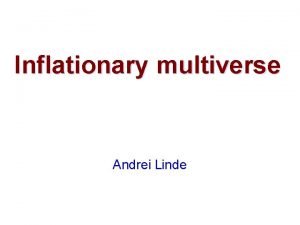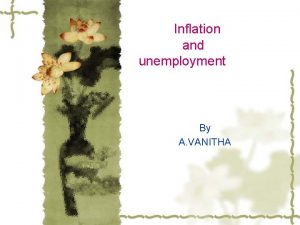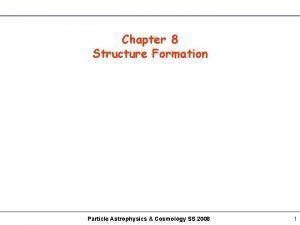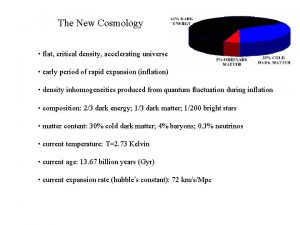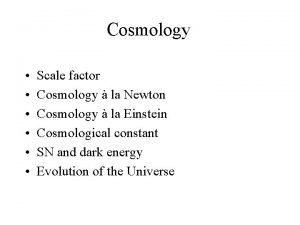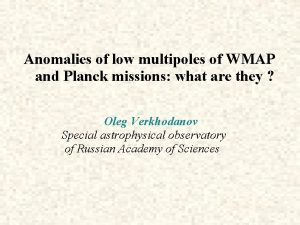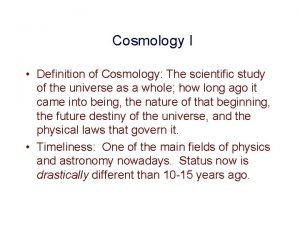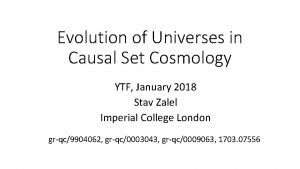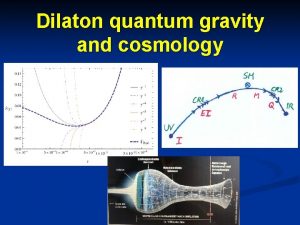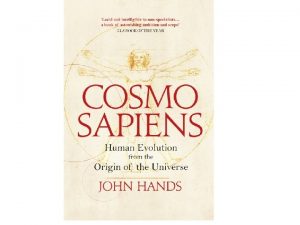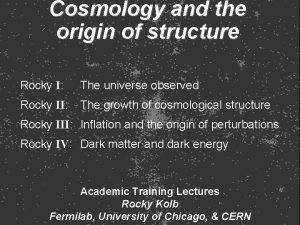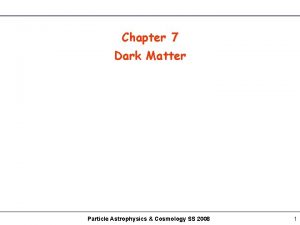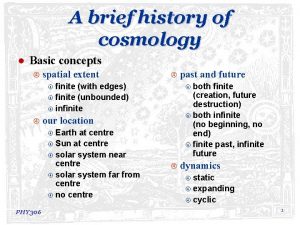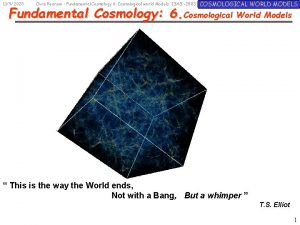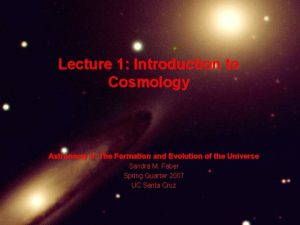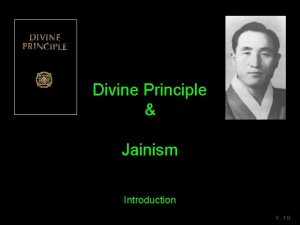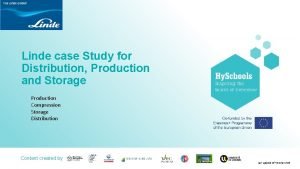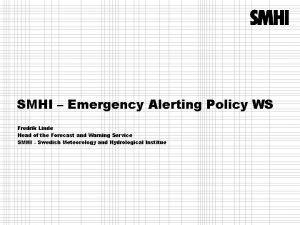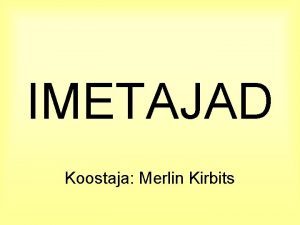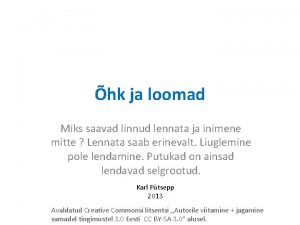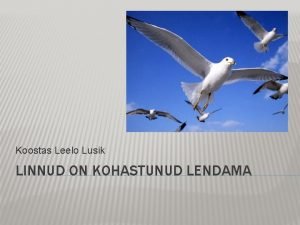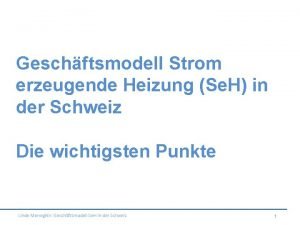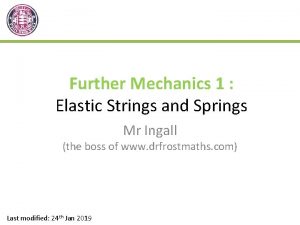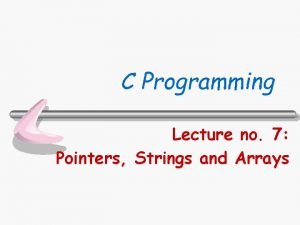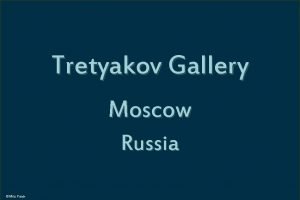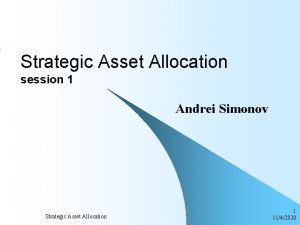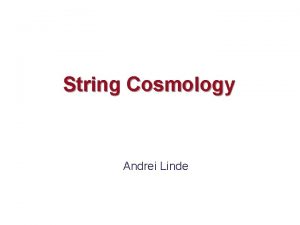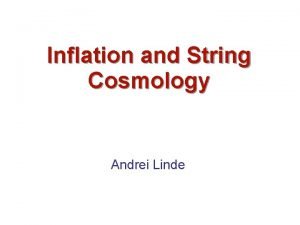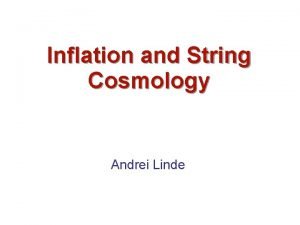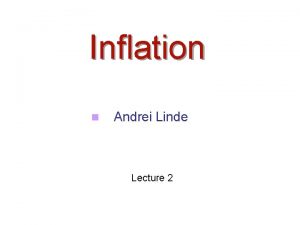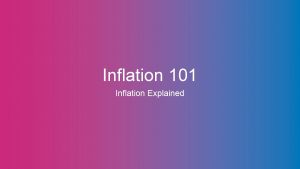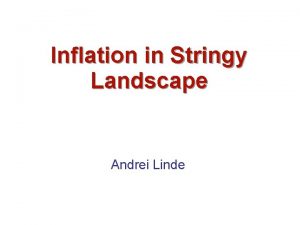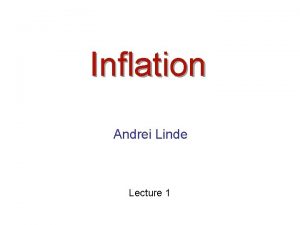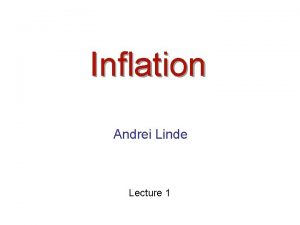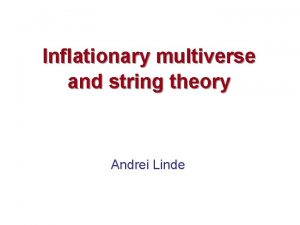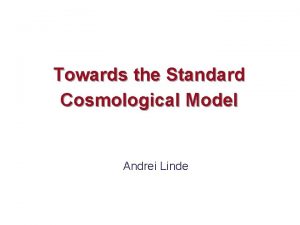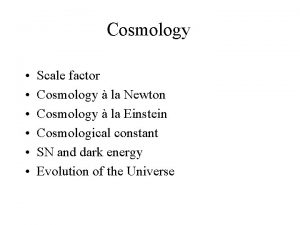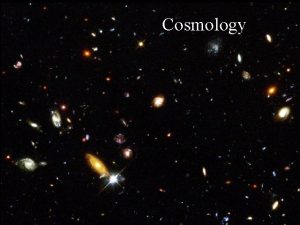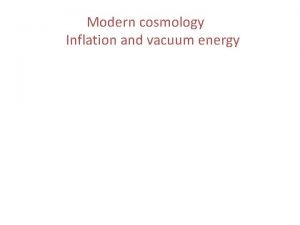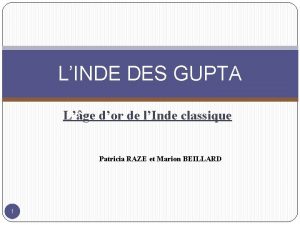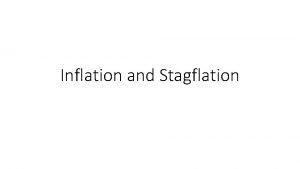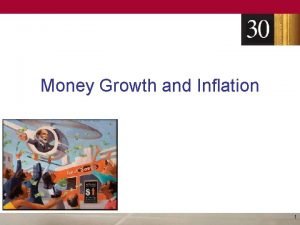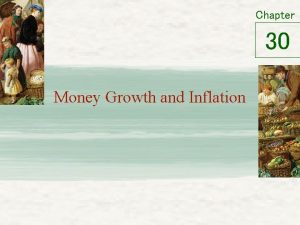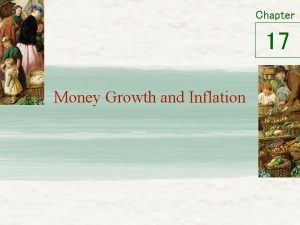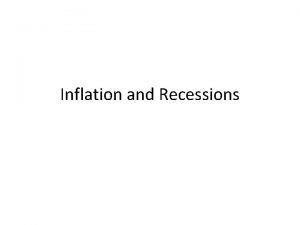Strings and Cosmology Andrei Linde Contents 1 Inflation


































- Slides: 34

Strings and Cosmology Andrei Linde

Contents: 1. Inflation and dark energy in i) supergravity ii) string theory 2. Testing string theory with CMB 3. Landscape and beyond

Chaotic Inflation Eternal Inflation

CMB and Inflation Blue and black dots - experimental results (WMAP, ACBAR) Brown line - predictions of inflationary theory

Predictions of Inflation: 1) The universe should be homogeneous, isotropic and flat, = 1 + O(10 -4) [ Observations: it is homogeneous, isotropic and flat: 2) Inflationary perturbations should be gaussian and adiabatic, with flat spectrum, ns = 1+ O(10 -1). Spectral index ns slightly differs from 1. (This is an important prediction, similar to asymptotic freedom in QCD. ) Observations: perturbations are gaussian and adiabatic, with flat spectrum:

Tensor modes: r =T/S Kallosh, A. L. 2007 If r > 0. 1, we may find tensor modes before 2011 If r ~ 0. 01, it may require another 10 years or so In all known inflationary models based on string theory r << 0. 01

Chaotic inflation in supergravity Main problem: Canonical Kahler potential is Therefore the potential blows up at large |φ|, and slow-roll inflation is impossible: Too steep, no inflation…

A solution: shift symmetry Kawasaki, Yamaguchi, Yanagida 2000 Equally good Kahler potential and superpotential The potential is very curved with respect to X and Re so these fields vanish. , But Kahler potential does not depend on The potential of this field has the simplest form, without any exponential terms:

PNGB inflation in supergravity Kallosh 2007 Shift symmetry KKLT-type superpotental The potential after the KKLT-type uplifting has a minimum at some value of the radial variable . The radial direction is very steep. At the minimum with respect to , the potential is that of the natural inflation: Here is the PNGB (axion) field

For b << 1, this model describes “natural inflation” proposed by Freese, Freiman and Olinto in 1990. Just as with the chaotic inflation, it took 17 years to implement this scenario in supergravity. It may take even longer to implement it in string theory. If one fine-tunes V 0 ~ 10 -120 in the potential one can describe the cosmological constant (CC). If, in addition, one fine-tunes V 1 ~ 10 -120, one can describe the dark energy. Thus, dark energy typically requires an additional fine-tuning as compared to CC, which does not make it particularly attractive.

Inflation in String Theory The volume stabilization problem: A potential of theory obtained by compactification in string theory of type IIB: X and Y are canonically normalized field corresponding to the dilaton field and to the volume of the compactified space; is the field driving inflation The potential with respect to X and Y is very steep, these fields rapidly run down, and the potential energy V vanishes. We must stabilize these fields. Dilaton stabilization: Giddings, Kachru, Polchinski 2001 Volume stabilization: KKLT construction Kachru, Kallosh, A. L. , Trivedi 2003

Basic steps of the KKLT scenario: 1) Start with a theory with runaway potential discussed above 2) Bend this potential down due to nonperturbative quantum effects 3) Uplift the minimum to the state with a positive vacuum energy by adding a positive energy of an anti-D 3 brane in warped Calabi-Yau space Ad. S minimum Metastable d. S minimum

Two types of string inflation models: Modular Inflation. The simplest class of models. They use only the fields that are already present in the KKLT model. Brane inflation. The inflaton field corresponds to the distance between branes in Calabi-Yau space. Historically, this was the first class of string inflation models.

Inflation in string theory KKLMMT brane-anti-brane inflation D 3/D 7 brane inflation Racetrack modular inflation DBI inflation (non-minimal kinetic terms)

String Cosmology and the Gravitino Mass Kallosh, A. L. 2004 The height of the KKLT barrier is smaller than |VAd. S| =m 23/2. The inflationary potential Vinfl cannot be much higher than the height of the barrier. Inflationary Hubble constant is given by H 2 = Vinfl/3 < m 23/2. V Modification of V at large H VAd. S Constraint on the Hubble constant in this class of models: H < m 3/2

Tensor Modes and GRAVITINO for inflationary perturbations Kallosh, A. L. 2007 superheavy gravitino unobservable A discovery or non-discovery of tensor modes would be a crucial test for string theory and particle phenomenology

If one suppresses the scale of inflation by 100 orders of magnitude (!), one will obtain dark energy (quintessence). No natural models of quintessence so far, but the cosmological constant is unavoidable: It appears in 101000 vacua in string theory landscape.

Inflationary Multiverse For a long time, people believed in the cosmological principle, which asserted that the universe is everywhere the same. This principle is no longer required. Inflationary universe may consist of many parts with different properties depending on the local values of the scalar fields, compactifications, etc.

Example: SUSY landscape Supersymmetric SU(5) V SU(5) SU(4)x. U(1) SU(3)x. SU(2)x. U(1) Weinberg 1982: Supersymmetry forbids tunneling from SU(5) to SU(3)x. SU(2)XU(1). This implied that we cannot break SU(5) symmetry. A. L. 1983: Inflation solves this problem. Inflationary fluctuations bring us to each of the three minima. Inflation make each of the parts of the universe exponentially big. We can live only in the SU(3)x. SU(2)x. U(1) minimum.

Landscape of eternal inflation

String Theory Landscape 1000 Perhaps 10 different uplifted worlds Lerche, Lust, Schellekens 1987 Bousso, Polchinski 2000; Susskind, Douglas, Denef 2003

String Theory Multiverse and eternal old inflation > 0 < 0 = 0

What is so special about our world? Problem: Eternal inflation creates infinitely many different parts of the universe, so we must compare infinities

Two different approaches: 1. Study events at a given point, ignoring growth of volume Starobinsky 1986, Garriga, Vilenkin 1998, Bousso 2006, A. L. 2006 The results depend on initial conditions. It is not clear whether these methods are appropriate for description of eternal inflation, where the exponential growth of volume is crucial. 2. Take into account growth of volume A. L. 1986; A. L. , D. Linde, Mezhlumian, Garcia-Bellido 1994; Garriga, Schwarz-Perlov, Vilenkin, Winitzki 2005; A. L. 2007 No dependence on initial conditions, but we are still learning how to do it properly. We will consider two examples: Dark matter and the cosmological constant.

Cosmological Constant (Dark Energy) is about 74% of the cosmic pie Dark Matter constitutes another 22% of the pie. Why there is 5 times more dark matter than ordinary matter?

Dark matter in the axion field Old lore: If the axion mass is smaller than 10 -5 e. V, the amount of dark matter in the axion field contradicts observations, for a typical initial value of the axion field. Can we give a scientific definition of “typical” ? Anthropic argument: Inflationary fluctuations make the amount of the axion dark matter a CONTINUOUS RANDOM PARAMETER. We can live only in those parts of the universe where the initial value of the axion field was sufficiently small (A. L. 1988). A detailed analysis: Aguirre, Rees, Tegmark, and Wilczek, 2005.

Anthropic Constraints on Axion Dark Matter Aguirre, Rees, Tegmark, and Wilczek, astro-ph/0511774 observed value The situation with Dark Matter is even better than with the CC !

One of the arguments in favor of light supersymmetric particles to be discovered at LHC is the possibility to explain the abundance of dark matter. As we see now, the same goal can be achieved by axions violating the naïve bound ma > 10 -5 e. V.

Inflation and Cosmological Constant 4 steps in finding the anthropic solution of the CC problem: 1) Anthropic solutions of the CC problem using inflation and fluxes of antisymmetric tensor fields (A. L. 1984), multiplicity of KK vacua (Sakharov 1984), and slowly evolving scalar field (Banks 1984, A. L. 1986). We considered it obvious that we cannot live in the universe with 2) 3) but the proof was needed for positive 2) Derivation . of the anthropic constraint Weinberg 1987; Martel, Shapiro, Weinberg 1997, …

Inflation and Cosmological Constant 3) String theory landscape Multiplicity of (unstable) vacua: Lerche, Lust and Schellekens 1987: 101500 vacuum states Duff, 1986, 1987; Bousso, Polchinski 2000 Vacuum stabilization and statistics: KKLT 2003, Susskind 2003, Douglas 2003, … perhaps 101000 metastable d. S vacuum states - still counting… 4) Counting probabilities in an eternally inflating universe (more about it later)

Anthropic constraints on : The main idea Anthropic bound Before quantum corrections After quantum corrections

Volume-weighted probabilities and the landscape Clifton, Shenker, Sivanandam, ar. Xiv: 0706: 3201 Assumption: Volume-weighted probability measure, A. L. , ar. Xiv: 0705. 1160. The main source of volume of new bubbles is the tunneling from the fastest growing d. S vacua with large vacuum energy towards the anthropic sphere with. If the tunneling occurs sequentially, between the nearby vacua, the process typically moves us to a minor fraction of the anthropic sphere with one of the fluxes being much greater than all others. This allows sharp predictions. One of the predictions - vacuum decay few billion years from now. However, if the tunneling with large jumps is possible due to nucleation of large stacks of branes (which seems plausible during the tunneling from the high energy d. S vacua), then the probability distribution on the anthropic sphere becomes rather uniform, no doomsday.

This model shows in a more detailed way how one can solve the CC problem in the string landscape scenario. It also demonstrates that the observable properties of our world and its fate may depend on the mechanism of the population of the landscape during eternal inflation.

Conclusions: There is an ongoing progress in implementing inflation in supergravity and string theory. String theory can describe the cosmological constant, but quintessence does not come easy. CMB can help us to test string theory. If inflationary tensor modes are discovered, we may need to develop a new class of stringy models, or phenomenological models with superheavy gravitino. Looking forward, we must either propose something better than inflation and string theory in its present form, or learn how to make probabilistic predictions based on eternal inflation and the string landscape scenario.
 Andrei linde multiverse
Andrei linde multiverse Types of unemployment
Types of unemployment Cosmology
Cosmology Critical density cosmology
Critical density cosmology Scale factor cosmology
Scale factor cosmology Axis of evil cosmology
Axis of evil cosmology Definition of cosmology
Definition of cosmology Stav zalel
Stav zalel Crossover cosmology
Crossover cosmology Concordance model of cosmology
Concordance model of cosmology Cosmology
Cosmology Cosmology
Cosmology Newton cosmology
Newton cosmology Cosmology
Cosmology Intro to cosmology
Intro to cosmology Jain cosmology
Jain cosmology Pakistan oxygen limited
Pakistan oxygen limited Linde cryopump
Linde cryopump Fredrik linde
Fredrik linde Martine linde
Martine linde Merlin linde
Merlin linde Bindungsordnung
Bindungsordnung Merlin kirbits
Merlin kirbits Merlin linde
Merlin linde Carte de linde
Carte de linde Linnu välisehitus
Linnu välisehitus Linde meneghin
Linde meneghin Aei maj
Aei maj Ceiiinosssttuu
Ceiiinosssttuu Pointers and strings
Pointers and strings String and other things
String and other things Vasily vereshchagin
Vasily vereshchagin Andrei starinets
Andrei starinets Andrei simonov
Andrei simonov Andrei jeltsov
Andrei jeltsov
